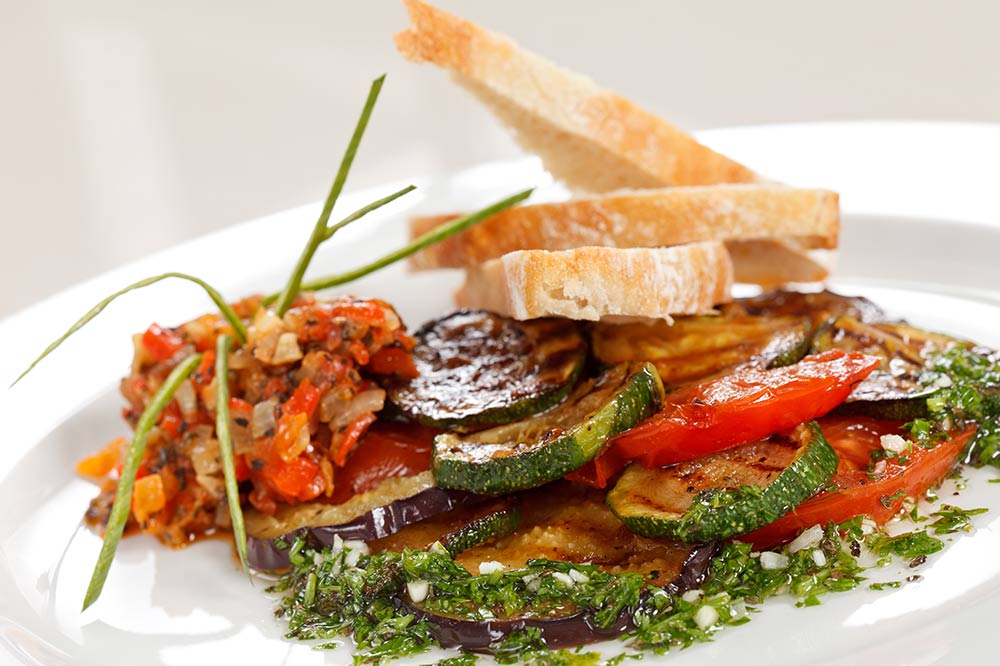A certain long-running animated television show once claimed “You don’t win friends with salad,” but is that really the case? Are vegetables really that disliked?
Not when you know what to do with them!
More and more, vegetables are becoming the stars of entrees in restaurants across America, with animal-based proteins taking a back seat. However, this plant-centric dining is not just for vegans and vegetarians. These are dishes that often still feature meat, simply taking “skinny” portion control for their proteins or relegating them to flavor components or accents only. The elusive omnivore can get in on the hard core veggie action, and restaurants (even fast food and fast casual) are certainly starting to accommodate them.
Again, there hasn’t necessarily been a big rise in actual vegetarian cuisine or behavior. This new generation of diners simply want to eat more vegetable-focused dishes. They’re looking for healthier options and ways to get in their daily veggie requirement when eating out. While some lean heavily towards being vegetarians, they typically like the flexibility of eating meat every once in a while (without going overboard with the protein).
The goal really becomes about putting the vegetable front and center – it is no longer the “supporting actor” in this ensemble. Meats and animal-based fats are still there, but simply as one of many flavors, with the veggie component taking center stage. While you’ll want to be clear that there is still meat in the dishes, being able to jump on this trend and include “flexitarian” dishes on your menu could mean big business for your restaurant.

What about flavor?
How can you get the most flavor layering out of these type of vegetable-centric dishes? Searing, charring, grilling … all great ways to get those beautiful sweet flavors out of veggies. This process can also create great texture variations, avoiding having all of your vegetable components reduced to the same mushy consistency.
Roasting and rotisserie aren’t just for that chicken anymore, and can also bring out more flavor. Then chefs can use a protein to create beautiful sauces or broths. A beef stock or chicken consommé poured around your roasted vegetables could be divine. Or give it a savory twist right from the start: poach a fennel bulb in veal stock, making it a tender, delicious bite. As long as your goal isn’t to make a dish strictly vegetarian, then animal-based cooking methods are fair game!
Braise Belgian endive in chicken stock or fry up Brussels sprouts in animal fat. Radicchio is typically reserved as filler in salads, but this bitter lettuce can be given new life if you grill it! Got a wood-fire oven? Even better. Pair those greens with some spicy chorizo hash as a side with your protein/starch components.
Succotash is another very versatile dish that doesn’t necessarily need to be vegetarian. Consider making this with edamame, roasted carrots, grilled sweet corn, and crumbled smoked bacon generously mixed in.

Seasonal offerings
Start thinking about the fall and winter months in terms of seasonal vegetables. What about squash? This hearty veggie is often used in soups, but including it as the main part of your entrée can be both economical and versatile.
Roast squash to bring out the most flavor. Slice ribbons of winter squash to make squash “Carpaccio,” accompanied by prosciutto and toasted pumpkin seeds. Pickled butternut squash shows some flair with preservation cooking techniques and adds a sour tang to your entrée. Even just cooking your butternut squash in bacon fat can bring a salty, savory pork element to your vegetable-focused dish.
And don’t forget squash blossoms! These delectable items can be stuffed with any number of cheeses and herbs, and then deep-fried for a delightful main course.

Toast bars
Another big winner when it comes to vegetable-focused cuisine? Toast bars. This growing trend is all the rage at lunch and breakfast spots, with toasters on every table accompanying your choice of bread type.
Toast bars bring to mind breakfast and comfort foods, but comfort doesn’t need to mean heavy and unhealthy. Sure, include sweet housemade fruit jams and butters, but don’t be afraid to go savory with vegetables as well.
Consider producing thick vegetable purees with some sliced radish on top for that much needed crunch. Roasted beets and caramelized onions with ricotta is a great pairing. How about avocado with sprouts, pesto, and a little goats cheese? Or maybe a smear of pate topped with sautéed mushrooms and microgreens? The possibilities are endless!
Don’t forget about the humble tomato jam – paired with a quail egg and a little chiffonade of basil, you could have a real hit. And of course the fun of a toast bar is that the guests can pick and chose for themselves. Make sure to ask your customers which combinations they liked the best so you can keep the most popular options on the menu and rotate the others seasonally.
Ultimately, the best thing about the veggie-focused menu trend is that it’s so very versatile. The suggestions above are only a few examples. Yes, you can nab any of those ideas for your restaurant, but why stop there? There’s a whole world of vegetable-centered menu items ready to become a hit at your restaurant. And your flexitarian guests will certainly thank you for it.
Looking to make other adjustments to your menu? Download our free eBook “How to Use Restaurant Menu Design to Increase Your Sales” today:






